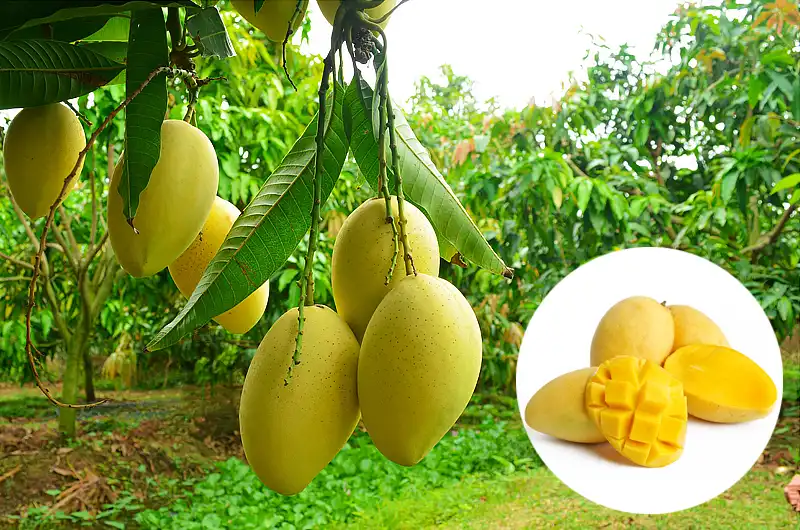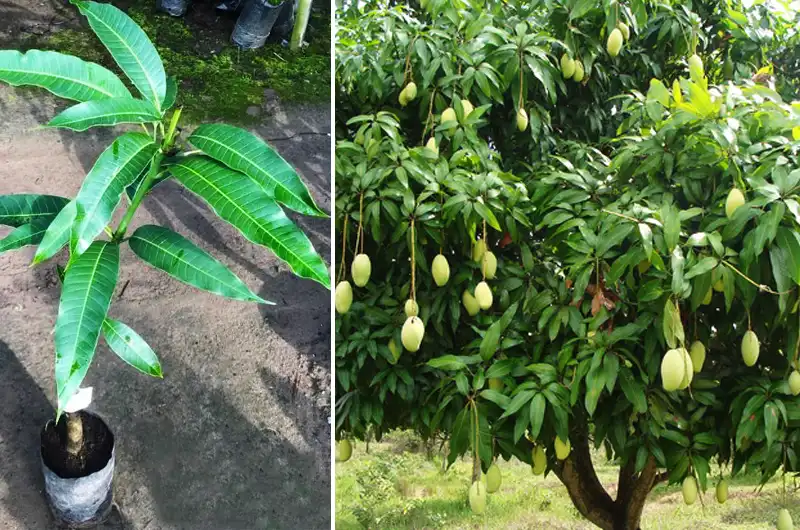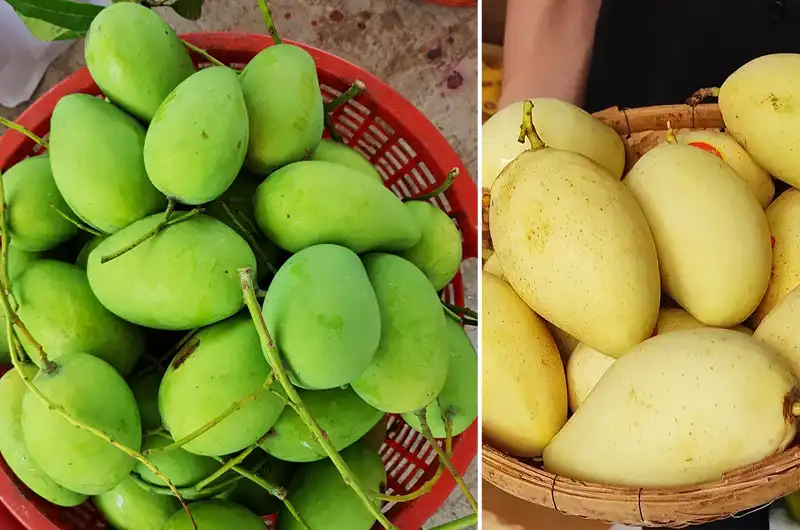Cat Chu mangoes are a very common and popular mango variety in Vietnam. The following is detailed botanical information about this mango variety.
What is The Scientific Name of Cat Chu Mango?
Cat Chu mangoes belong to the species Mangifera indica L. Furthermore, people typically write the variety name as Mangifera indica ‘Cat Chu’.
Where Did Cat Chu Mangoes Originate?
Cat Chu mangoes first came from the Cao Lãnh region in Đồng Tháp province, Vietnam. Indeed, many consider this region the “capital” and the place where this mango variety develops its best qualities.

Main Growing Regions of Cat Chu Mangoes:
Đồng Tháp province, particularly Cao Lãnh city and its neighboring districts, is where farmers most extensively grow Cat Chu mangoes, and where the variety is most renowned. In addition, farmers also cultivate this mango variety in many other provinces throughout the Mekong Delta and some southeastern provinces, primarily due to its relatively good adaptability.
What is The Botanical Morphology of the Cat Chu Mango Tree?
Young Tree Characteristics:
The young trunk usually appears light green or slightly purple and features smooth bark. Notably, the tree grows in flushes (or spurts) of shoots. When young leaves first emerge, they are often a beautiful coppery red or purplish pink, soft, and drooping. Then, after about 1–2 weeks, these leaves gradually turn light green, straighten out, and become firmer. Typically, young leaves grow in clusters at the branch tips. Furthermore, the shape of young leaves is also lanceolate (long and tapering at both ends), similar to mature leaves but smaller in size.
Mature Tree Characteristics:
- The Cat Chu mango is a large woody tree with grayish-brown bark. As the tree ages, the bark often becomes rough and develops many vertical cracks along the trunk. The trunk of the Cat Chu mango tree is very sturdy.
- Leaves are simple, alternate, usually clustered at the branch tips. Leaves are lanceolate and elongated with a pointed or slightly rounded tip and a wedge-shaped base. The upper surface of the leaf is dark green, glossy with prominent veins, and the lower surface is lighter in color. The leaves range from 15–30 cm in length and 3–7 cm in width; this size varies depending on the age of the branch and growing conditions. When crushed, the leaves emit a characteristic mild aroma.

Mature Tree Size:
- The trunk diameter of mature Cat Chu mango trees (from 10–20 years old and above) usually ranges from 30–60 cm, depending on the tree’s age and care conditions. Older trees can have a larger diameter.
- The canopy of the Cat Chu mango tree develops round and dense. The canopy of a mature tree can span from 8 meters to 15 meters. With well-cared-for trees and unrestricted space, the canopy can be even larger.
- The maximum height of a Cat Chu mango tree can reach about 10 meters to 20 meters. Under ideal conditions and without pruning to control height, the tree can grow taller.
What is The Morphology of the Cat Chu Mango Fruit?
Unripe Fruit
- The fruit is elongated in shape, slightly rounded at the stem end, and tapers towards the bottom. The bottom of the fruit is usually pointed and slightly curved. The fruit has a fairly distinct ventral shoulder.
- The skin of the unripe fruit is dark green and glossy. As it grows larger, the green color may lighten slightly.
- The flavor of unripe Cat Chu mango is very tart. When the fruit reaches its maximum size but is not yet ripe (often called green mango, used for eating fresh or in salads), the sourness is milder and may have a slight sweetness depending on the “maturity” of the fruit.
- The flesh of unripe Cat Chu mango is very crisp and firm. As it approaches ripeness, the crispness gradually decreases.
Ripe Fruit:
- Retains its characteristic elongated shape but appears fuller and rounder than when unripe.
- The skin is thin, smooth, and the color when ripe turns light yellow, gradually deepening to a richer yellow when fully ripe. Some fruits may have a slight pink blush on the shoulder exposed to sunlight.
- The flavor of ripe Cat Chu mango is mildly sweet, not overly intense, accompanied by a mild, characteristic, and very pleasant aroma. This is one of the outstanding features that makes this mango variety famous.
- The flesh of ripe Cat Chu mango is light yellow, thick, firm, with a fine texture, very little or almost no fiber, tender but not mushy. The seed is small, flat, and easy to separate.

In recent years, Cat Chu mangoes have become a major mango variety in Vietnam, boasting large and stable export volumes. Furthermore, Vietnamese growers and exporters have actively made efforts to improve quality, aiming to meet the increasingly strict requirements of demanding markets such as the United States, the EU, Japan, South Korea, and Australia. Notably, this variety also demonstrates a relatively good tolerance to irradiation treatment, which is crucial for gaining access to some export markets. Consequently, with its mild sweetness, gentle aroma, smooth flesh, minimal fiber, and moderate size, it effectively suits the taste preferences of many consumers, including those in America.
Read more articles about Mango:
Latest Posts:


